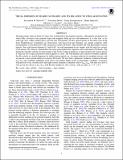THE Hα EMISSION OF NEARBY M DWARFS AND ITS RELATION TO STELLAR ROTATION
Author(s)
Irwin, Jonathan; Charbonneau, David; Berlind, Perry; Calkins, Michael L.; Mink, Jessica; Newton, Elisabeth R; ... Show more Show less
DownloadNewton-2017-THE H alpha EMISSION OF NEARBY M D.pdf (11.72Mb)
PUBLISHER_POLICY
Publisher Policy
Article is made available in accordance with the publisher's policy and may be subject to US copyright law. Please refer to the publisher's site for terms of use.
Terms of use
Metadata
Show full item recordAbstract
The high-energy emission from low-mass stars is mediated by the magnetic dynamo. Although the mechanisms by which fully convective stars generate large-scale magnetic fields are not well understood, it is clear that, as for solar-type stars, stellar rotation plays a pivotal role. We present 270 new optical spectra of low-mass stars in the Solar Neighborhood. Combining our observations with those from the literature, our sample comprises 2202 measurements or non-detections of Hα emission in nearby M dwarfs. This includes 466 with photometric rotation periods. Stars with masses between 0.1 and 0.6 M[subscript ⊙] are well-represented in our sample, with fast and slow rotators of all masses. We observe a threshold in the mass–period plane that separates active and inactive M dwarfs. The threshold coincides with the fast-period edge of the slowly rotating population, at approximately the rotation period at which an era of rapid rotational evolution appears to cease. The well-defined active/inactive boundary indicates that Hα activity is a useful diagnostic for stellar rotation period, e.g., for target selection for exoplanet surveys, and we present a mass-period relation for inactive M dwarfs. We also find a significant, moderate correlation between L[suscript Hα]/L[subscript bol] and variability amplitude: more active stars display higher levels of photometric variability. Consistent with previous work, our data show that rapid rotators maintain a saturated value of LHα/Lbol. Our data also show a clear power-law decay in L[subscript Hα]/L[subscript bol] with Rossby number for slow rotators, with an index of −1.7 ± 0.1.
Date issued
2017-01Department
MIT Kavli Institute for Astrophysics and Space ResearchJournal
The Astrophysical Journal
Publisher
IOP Publishing
Citation
Newton, Elisabeth R. et al. “THE Hα EMISSION OF NEARBY M DWARFS AND ITS RELATION TO STELLAR ROTATION.” The Astrophysical Journal 834.1 (2017): 85. © 2017 The American Astronomical Society
Version: Final published version
ISSN
1538-4357